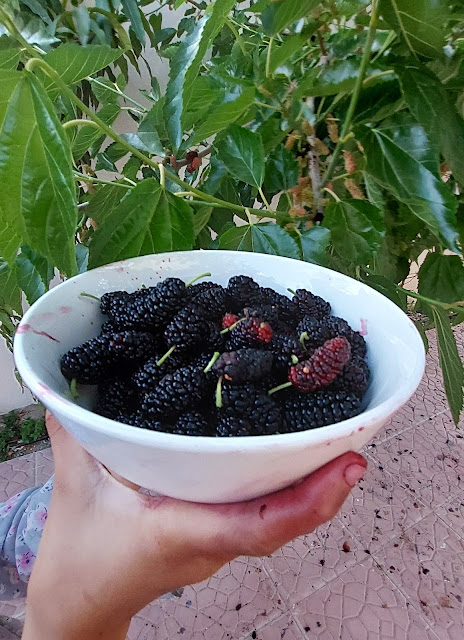Seeding the silk route feeding on a humble plant…
Around 7000 years ago, the Chinese invented the art and science of spinning cocoons of silkworms into smooth thread and weaving it into the lustrous fabric for the fabulously rich world. They raised silkworms feeding on cultivated white mulberry plants. The secret was successfully guarded for thousands of years and resulted in one of the largest travel and transport networks, later known as the silk route, over land and sea. Traders travelled to distant lands on foot, on horseback or by caravan, following a confluence of trails leading to China, and brought the silk and sold it at bazaars and caravanserais en route. (Caravanserais were roadside inns where travelers – caravaners - could rest and recover from the day's journey.) The route connected the civilizations in the East and the West for about 1400 years.
I captured this photo of our
daughter Aishah holding a bowl of sun-ripe mulberry freshly plucked in the little garden of our property owner,
Abdul Azeez Abdullah Yahya Ajeem, a man with truly green fingers. He had
planted this mulberry tree a few years before I rented an apartment on the
ground floor. Reading my interest in plants, he readily entrusted the care of
his plants to me.
Back to our silky story.
Chinese rulers sent gifts of silk to their counterparts in Persian and other
West Asian countries then, spreading the fame of silk further west. The custom
of handing out free samples is as old as silk itself. My mom seemed to know this
as she used to send a glass of milk to each house in the neighborhood every
time her cow had a calf, often landing orders for a regular supply of one or
two glasses of milk every morning or evening until the cow stopped lactating.
The only difference is that she did not differentiate between potential
customers and the rest.
About the time of Jesus
Christ, it became fashionable among the rich and powerful to wear silk, the
Roman rulers setting the trend. The countries along the silk route also got
their share of bounty in the form of road tax and silky gifts in return for the
safe passage of their costly merchandise. The Kushanas, who then ruled north, central,
and northwest India, became very prosperous, having their centers in Mathura
and Peshawar. Their ports at the mouth of the Indus were used to ship silk to the
Roman Empire. As Peter Frankopan put it: “Money, rather than men, began to be
used as currency for trade with the East.” Naturally, the Kushana’s gold coins
became the currency in circulation along the route.
Colin Thubron wrote in his
Shadow of the Silk Road: “To follow the Silk Road is to follow a ghost. It
flows through the heart of Asia, but it has officially vanished leaving behind
the pattern of its restlessness: counterfeit boarders, unmapped peoples. The
road forks and wanders wherever you are. It is not a single way, but many: a
web of choices.”
Of late, China - being a
world power - revived its interests in silk routes and began diplomatic
negotiations to build such a mega network connecting the world much better. Thus,
the Silk Road Economic Belt and the Maritime Silk Road were born, which were
successful to an extent. These were obviously meant to export their product and
sell them on the world market, much more aggressively than in their mulberry
days.
It is rather astounding
that a humble worm – the silkworm – feeding on a humble plant – the mulberry
bush – could have given rise to a global industry. It is equally astounding
that the Chinese, who discovered the origin and potential of silk, could guard
their secret for so long. Their trade secret would not have lasted nearly as
long in modern times. I wonder if Europeans had an inkling of the origin of
silk, when the English nursery rhyme saw the light of day: “Here we go round
the mulberry bush, The mulberry bush, The mulberry bush. Here we go round the
mulberry bush, On a cold and frosty morning.” My guess? No. The mulberry bush
in the nursery rhyme could have been any old bush brave enough to survive the
English climate. Luckily, the Chinese recognized its worth and knew it was not
just “any old bush”.




Comments
Post a Comment